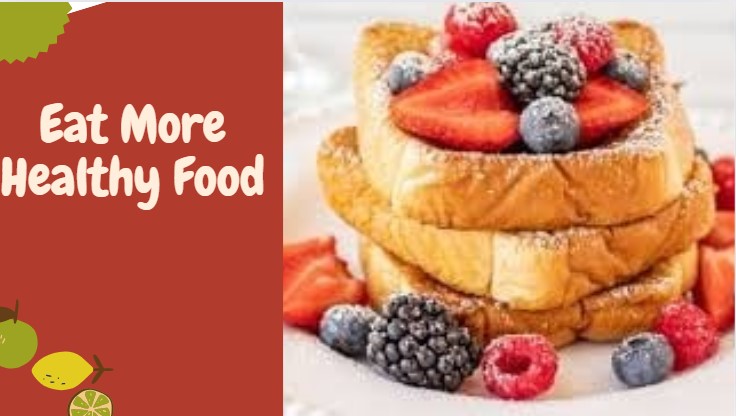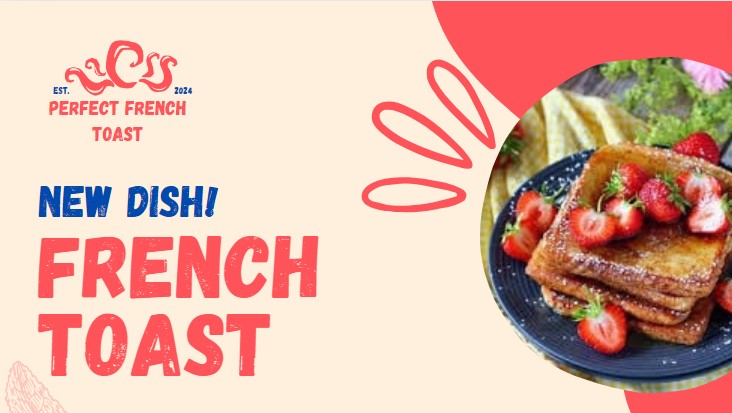How to Make Perfect French Toast: A Step-by-Step Guide
Many love French Toast. Its sweet, comforting taste and texture make it a breakfast classic. Whether it’s a weekend breakfast or a weekday treat, you must master French Toast. This guide will show you how to make perfect French Toast. It should be crispy on the outside, fluffy on the inside, and full of flavor
What You’ll Need: Ingredients and Equipment
Before we dive into the recipe, let’s gather everything you’ll need. French Toast is beautiful in its simplicity.
Ingredients:
- Bread: 4-6 slices of thick bread (brioche, challah, or Texas toast are ideal).
- Eggs: 3 large eggs.
- Milk or cream: 1/2 cup for a creamier texture.
- Cinnamon: 1 teaspoon for a warm, spiced flavor.
- Vanilla extract: 1/2 teaspoon (optional, but highly recommended for added richness).
- Butter: For frying, about 2 tablespoons.
- Toppings: Syrup, powdered sugar, fresh berries, whipped cream, or any of your favorites.
Equipment:
- Mixing bowl
- Whisk or fork
- Frying pan or griddle
- Spatula
Step-by-Step Instructions
1. Prepare the Egg Mixture
Whisk them thoroughly until the yolks and whites are fully combined. Add the milk or cream, cinnamon, and vanilla extract to the eggs. Whisk again until everything is well mixed. This egg mixture is the key to French Toast’s rich, custard-like consistency
2. Soak the Bread
Next, take each slice of bread and dip it into the egg mixture. Coat both sides evenly. Don’t soak the bread too long. It should absorb the flavors but not get soggy. Use thicker bread, like brioche or challah. It absorbs the mixture without falling apart.
3. Heat the Pan
Place your frying pan or griddle on medium heat. Add a tablespoon of butter and let it melt, spreading it evenly across the surface. The butter will give the French Toast a beautiful golden-brown color and a rich, buttery taste.
4. Cook the French Toast
When the margarine is sizzling, place the absorbed bread cuts the skillet. Cook them for about 2-3 minutes on each side, or until they’re golden brown and slightly crispy. Watch the heat. If it’s too high, the bread will burn before the inside cooks. If it’s too low, it won’t get crispy.
5. Serve Hot
Transfer the cooked French Toast to a plate and add your favorite toppings. A drizzle of syrup, a dusting of sugar, and some berries make for a classic dish. But feel free to get creative—add whipped cream, chocolate chips, or even a dollop of yogurt for a unique twist.
Tips for the Best French Toast

Bread Selection: The type of bread you use can make or break your French Toast. Use thick slices of brioche or challah. They assimilate the egg blend without self-destructing. For extra fluffiness, slightly stale bread works better. It soaks up more of the mixture without getting too soft.
Soaking Time: Don’t rush this step! The bread needs time to absorb the egg mixture fully, but be careful not to soak it for too long, or it will turn to mush. A quick dip on each side is usually enough for the perfect balance.
Cooking Tips: To get a golden-brown color, cook your French Toast on medium heat. Too high, and it will burn; too low, and it won’t crisp up. Use enough butter in the pan to prevent sticking and add flavor.
Flavor Enhancements: Don’t be afraid to experiment with different flavors. A pinch of nutmeg or a splash of orange zest can elevate your French Toast to a whole new level. For a richer taste, try using half-and-half or heavy cream instead of milk.
Variations of French Toast
French Toast is very versatile. Once you know the basics, you can try many variations to keep it interesting.
Stuffed French Toast: For a treat, stuff your French Toast with cream cheese, Nutella, or fruit. Simply spread your filling on one slice of bread, top it with another slice, and proceed with the recipe as usual.
Savory French Toast: If you’re not in the mood for something sweet, you can make a savory version. Skip the cinnamon and vanilla, and instead, season your egg mixture with salt, pepper, and herbs. Serve with cheese, bacon, or sautéed mushrooms for a hearty breakfast.
Vegan French Toast: For a plant-based option, use a mix of almond milk and ground flaxseeds instead of the eggs. Coconut milk also works well if you want a tropical twist.
French Toast Casserole: It’s perfect for a crowd.Layer your bread slices in a baking dish. Pour the egg mixture over them. Refrigerate overnight.
Common Mistakes to Avoid
Even with a simple recipe like French Toast, there are a few pitfalls to watch out for:
- Over-soaking the bread: Too much time in the egg mixture can make the bread soggy. A quick dip is all it needs.
- Cooking on the wrong heat: Too high heat can burn the outside and leave the inside uncooked. Medium heat is the sweet spot.
- Using the wrong bread: Thin or very fresh bread can fall apart when soaked. Stick with thick, slightly stale slices for the best results.
Frequently Asked Questions (FAQ)
Can I make French Toast with stale bread? Absolutely! Marginally lifeless bread is best for French Toast.
How do I prevent soggy French Toast? To avoid soggy French Toast, use thick, slightly stale bread and don’t soak it too long in the egg mixture. Also, make sure your pan is at the right temperature—medium heat works best.
Can I freeze French Toast for later? Yes, you can! Cook the French Toast as usual, then let it cool completely.

is a digital marketing consultant with a passion for advanced living, is the man behind this blog, where he shares his love for all things kitchen and culinary trends to help you elevate your cooking experience.



